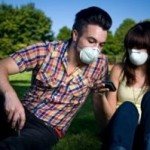 Air pollution has always totally freaked me out because for the most part you can’t see it. Granted, as I’m flying into LAX in the Summer months, I always see a rather unpleasant gray/purple haze hanging over the entire city, which is obviously SMOG, but I’ve often wondered how LA compares to other cities in the full-on air pollution department. So this morning a logged onto Scorecard and snooped around a bit. The first mega surprise is that the North West Arctic is listed as #1 in “Worst Polluted Area”! Number ONE – hello, we’re talking about the Arctic – sparkling glaciers and what I would have imagined to be the cleanest air on Earth
Air pollution has always totally freaked me out because for the most part you can’t see it. Granted, as I’m flying into LAX in the Summer months, I always see a rather unpleasant gray/purple haze hanging over the entire city, which is obviously SMOG, but I’ve often wondered how LA compares to other cities in the full-on air pollution department. So this morning a logged onto Scorecard and snooped around a bit. The first mega surprise is that the North West Arctic is listed as #1 in “Worst Polluted Area”! Number ONE – hello, we’re talking about the Arctic – sparkling glaciers and what I would have imagined to be the cleanest air on Earth
. I then thought I’d get a bit more local. They have a feature on Scorecard where you can compare the pollution in your zip code to another zip. I typed in my zip code and then my mother-in-law’s She lives in the heart of Southern GA and will have nothing bad said about her area – as far as she’s concerned it’s about as close as you can get to Paradise as you can get (it is lovely with all those tree-lined paths surrounding her home,) hmmmmm, I thought: what if her Paradise is worse off than smoggy old LA???? Nope – the results were clearly laid out in a graph: LA had a huge red block underneath it on all pollution counts and Lauren’s County only had a yellow block – meaning that it’s much less polluted, however, perhaps not quite perfect!!! The worst state for cancer- risk- by- pollution, is New York.
She lives in the heart of Southern GA and will have nothing bad said about her area – as far as she’s concerned it’s about as close as you can get to Paradise as you can get (it is lovely with all those tree-lined paths surrounding her home,) hmmmmm, I thought: what if her Paradise is worse off than smoggy old LA???? Nope – the results were clearly laid out in a graph: LA had a huge red block underneath it on all pollution counts and Lauren’s County only had a yellow block – meaning that it’s much less polluted, however, perhaps not quite perfect!!! The worst state for cancer- risk- by- pollution, is New York.
So what can we do in the face of all this dreadful pollution, which for the most part is caused by Diesel Emissions? Sign  this very important petition disallowing backroom deals for polluters. Always remember that e-activism is so powerful and that just by adding your signature, you’re speaking out loudly and clearly for what you want – trust me, your voice gets heard.
this very important petition disallowing backroom deals for polluters. Always remember that e-activism is so powerful and that just by adding your signature, you’re speaking out loudly and clearly for what you want – trust me, your voice gets heard.
Air pollution is also caused by:
Industrial and manufacturing processes and waste
Cars and other vehicles that burn fossil fuels
Volcanoes
Fuel combustion
Power generation
Aerosol cans
Explosives
Methane gas from animal waste
Smoking
Chemical and fuel leaks and spills
There are several air pollutants that are organic in nature, but the vast majority of them are man made and controllable.
What can we do in our own homes to minimize our exposure to harmful pollutants?
Even if you live far from city life and are surrounded by trees and plants that help filter out environmental contaminants, it’s nearly impossible to escape indoor air pollution. You can help prevent exposure to air pollution in your home with these simple steps:
 1. Buy an air purifier, one with a HEPA (high-efficiency particulate air) filter.
1. Buy an air purifier, one with a HEPA (high-efficiency particulate air) filter.
2. Add living plants to your home.
3. Get rid of contributors to indoor pollution such as aerosol sprays, paints, incense and chemical products.
4.Eat lots of organic fruits and veggies daily, take a good quality anti-oxidant supplement and consider a Heavy Metal Cleanse Supplement annually.
If you have a Smart Phone, you can also download the new free Android App, Visibility, Where you point your camera towards the sky and it’ll show you how polluted the air is! iPhone version is on it’s way


